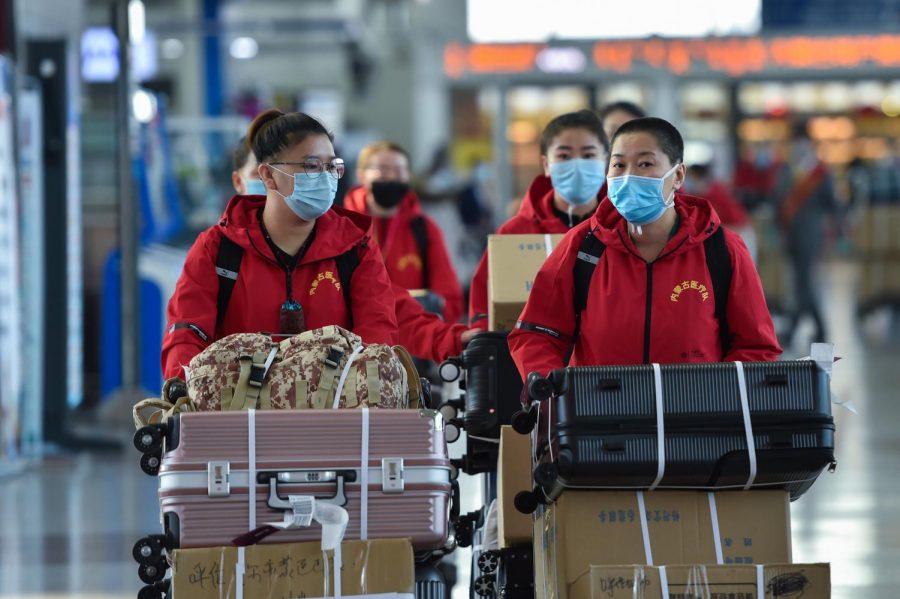Coronavirus: fact and fiction
Liu Lei/Xinhua
Medical team members prepare to check in at Hohhot Baita International Airport before leaving for Hubei Province in Hohhot, capital of north China’s Inner Mongolia Autonomous Region, on Tuesday, Feb. 18, 2020. The seventh batch of medical workers from Inner Mongolia Autonomous Region to Hubei Province departed Tuesday to help the novel coronavirus control efforts there. (Liu Lei/Xinhua/Zuma Press/TNS)
The novel coronavirus from Wuhan, China, has claimed more than 1,000 lives and sickened more than 43,000 others. One fatality, as well as 393 infections, have occurred outside of China, including 13 in the United States as of last week. Fortunately, the American patients are in good condition and have not become severely ill.
The data comes as China has quarantined Wuhan and 15 other cities, which collectively house almost 50 million people in an effort to fight the virus. The United States and other global powers have severely restricted travel to China. China has also banned motor vehicles from entering or exiting the cities in lockdown. The nation has ratified seven emergency laws related to the epidemic, with violations punishable by swift arrests, long prison terms and even death.
Outside of China, cruise lines have imposed two-week quarantines on all passengers should anyone on a ship test positive. Americans that have been evacuated by plane from Wuhan to California have been screened for symptoms multiple times and quarantined at a military base for fourteen days.
In the wake of this unprecedented, widespread panic, the American mass media has attempted to alleviate some of the panic by comparing the illness to seasonal influenza epidemics. During the 2019-20 flu season alone, 12,000 Americans died, 210,000 spent time in the hospital and over 22 million were sickened.
This winter has been severe because Influenza B viruses are the primary strains making the rounds. The Influenza A (H1N1) strain usually dominates, and Type B viruses do not usually emerge until much later in the season. Scientists consider this information when making the flu vaccine each year. Consequently, this season’s vaccine is not as effective, and infections and deaths are above average.
However, the general claim about the flu being worse than coronavirus may be a myth.
After crunching the numbers, it becomes evident that only one in 5,000 Americans with the flu die while more than one in 50 of those sick with coronavirus do not survive. While one in 1,000 influenza cases in 2019-20 have required hospitalizations, roughly one in five coronavirus patients were listed in serious or critical condition. Moreover, the new contagion has an incubation period of up to 14 days, much greater than one to four days for the flu. Unlike the flu, infected patients are contagious during this time. Longer incubation periods are undesirable due to the need to impose longer quarantines on those suspected of being exposed to the virus.
Another and perhaps greater reason to take the panic seriously is the disease’s high degree of uncertainty. The World Health Organization has announced that a vaccine for the new strain would be available in eighteen months. The number of cases in epidemics and pandemics grows exponentially. After infecting 40,000 and killing 1,000 in its first month, there is no telling how deadly the coronavirus could become in the next year and a half. By comparison, the 2002-03 SARS epidemic, which was also caused by a coronavirus, infected just over 8,000 people from November 2002 to June 2003.
“It’s a new virus. We don’t know much about it, and therefore we’re all concerned to make certain it doesn’t evolve into something even worse,” said Ian Lipkin, an infectious disease expert who is currently on a two-week quarantine as a result of traveling to China to study the outbreak. “We don’t know much about its transmissibility. We don’t necessarily have accurate diagnostic tests. And we don’t really know where the outbreak is going to go.”
Contrary to what some may believe, the symptoms of the new illness are much worse than most other respiratory infections, including influenza. Flu symptoms include extreme fatigue, high fever, severe headache, cough, sore throat and runny nose. The new coronavirus lacks the runny nose and sore throat but can cause a very severe fever and cough. Other symptoms not associated with other respiratory infections, such as difficulty breathing, reduced liver functionality and even kidney failure, are common.
Another myth about the virus claims that it was manufactured in a lab. There is also a rumor about the virus being patented and a vaccine being “magically” available. In reality, the virus first surfaced from a seafood market in Wuhan, and there will be no vaccine for the strain for up to eighteen months.
The severity of the epidemic has prompted the World Health Organization to declare a global health emergency on Jan. 30, even though there were just over 200 deaths and less than 10,000 global cases as of that date. Since then, the epidemic has worsened almost fivefold. “With 99 percent of cases in China, this remains very much an emergency for that country, but one that holds a very grave threat for the rest of the world,” Tedros Adhanom Ghebreyesus, director-general of the World Health Organization, warned Tuesday. He urged world leaders to “use the window of opportunity that we have now” to win the war against “a common enemy that does not respect borders or ideologies.”
Even though the potential for an international pandemic exists, with a high death toll and significant effects on the global economy, there is no immediate danger to residents of the United States at this time. Few Americans have the virus, and all of them are suspected of catching it from visiting China or interacting with people who had recently visited China. However, all interests in the United States (and the rest of the developed world) are advised to closely monitor the disease using official and credible sources. Social media should not be used to obtain updates.
Locally, New Hanover health officials have confirmed that there are no known cases of coronavirus in Wilmington or our area at large, despite an article deemed ‘fake news’ circulating the community recently.
If the level of risk rises, people are encouraged to wash their hands frequently, avoid touching their eyes, nose and mouth and cover their mouths when coughing or sneezing. Investing in an N95 face mask may also be necessary. Most importantly, though, patients are to isolate themselves and promptly see a doctor in case of severe cough coupled with high fever, especially if no other flu-like symptoms are present.
And finally, the Corona beer cannot transmit (or cure) coronavirus.












